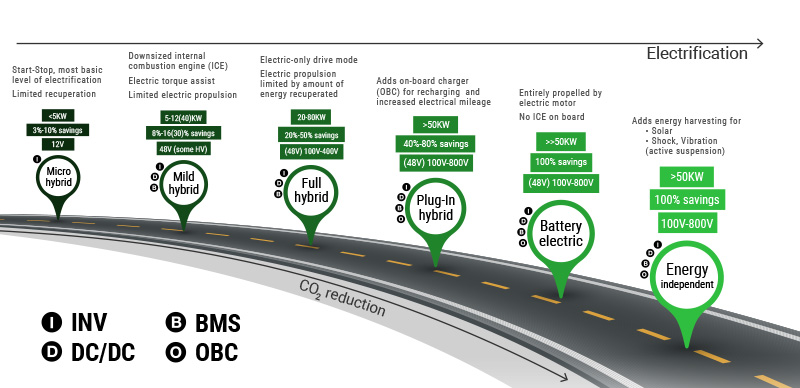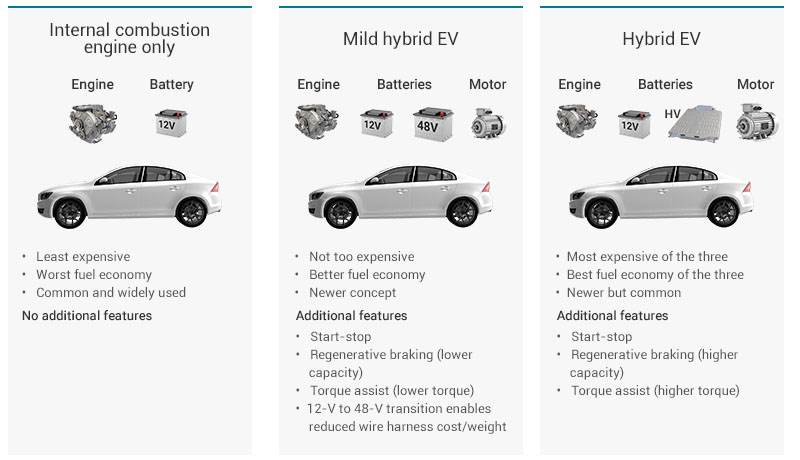SSZT162 may 2021 LM25180-Q1 , LM25183-Q1 , LM25184-Q1 , LM5163-Q1 , LM5180-Q1 , LM5181-Q1
Automotive emissions standards are becoming more stringent every year, making it challenging for internal combustion engine (ICE) car manufacturers to keep up. One of their efforts to reduce emissions involves electrifying the drivetrain, either partially or fully, to improve the effective efficiency of the engine, partially disable the engine or eliminate the engine completely (see Figure 1).
Of course, this electrification comes at a cost, and there lies the age-old engineering question: How do you balance cost with other design requirements?
In this article, I’ll discuss the 48-V mild hybrid electric vehicle (MHEV) and explain how this technology can deliver around two-thirds of the benefits of full hybrids at around one-third the cost.
 Figure 1 List of the Most Popular
Electrified Drivetrain Topologies
Figure 1 List of the Most Popular
Electrified Drivetrain TopologiesSystem Additions – MHEVs vs. Full Hybrids
An MHEV uses a 48-V battery to achieve many of the functionalities of a full hybrid at a fraction of the additional cost. Figure 2 compares the hardware and features of an ICE vs. an MHEV vs. a full hybrid. A typical full hybrid integrates a motor and a 200- to 400-V high-voltage battery with a capacity of around 1 to 2 kWh. An MHEV uses a smaller motor and a smaller 48-V battery with a capacity of less than 1 kWh, or a comparable supercapacitor. This smaller motor and significantly smaller battery greatly reduce cost and weight (and by extension fuel economy) of adding mild-hybrid to a vehicle versus full hybrid. The reduced hardware requirements offer less powerful performance when compared to a full hybrid, but as you’ll see, an MHEV can still provide the majority of the benefits at this reduced cost.
 Figure 2 Comparison Summary of ICE, MHEV and Full Hybrid Vehicles
Figure 2 Comparison Summary of ICE, MHEV and Full Hybrid VehiclesStart-stop Functionality
Start-stop greatly improves fuel economy in city driving or other start-stop environments by shutting off the ICE in such conditions. An MHEV battery does store less energy than a full hybrid high-voltage battery, but it has more than enough capacity to enable start-stop for the majority of conditions. It is possible to implement start-stop with a 12-V battery, but a 48-V battery endures less stress, which enables longer battery life. The 48-V start-stop does not have the same issues when dealing with 12-V voltage droop from cranking.
Regenerative Braking
Regenerative braking, as the name implies, captures the kinetic energy of a vehicle while the driver is braking. This energy normally dissipates into heat through the brake pads, but regenerative braking uses the mild or full hybrid motor as a generator to charge the mild or full hybrid battery. Regenerative braking, like start-stop, thrives in environments with lots of starting, stopping, accelerating and decelerating. The reduced capacity of the mild hybrid battery can limit the effectiveness of regenerative braking in some conditions, but is sufficient to recoup energy without running out of capacity in most city driving conditions.
Torque Assist
A hybrid motor connects to the drivetrain and uses energy from the hybrid battery to add torque when accelerating. Torque assist improves acceleration, which means that the vehicle can achieve the same acceleration performance with a smaller ICE. This saves engine cost and weight, which further improves fuel economy. A mild hybrid motor is smaller and less powerful than the full hybrid motor, which will limit the amount of added torque, but a mild hybrid motor can still provide the majority of torque assist benefits in many cases.
Reduced Harness Weight and Cost – an MHEV-specific Benefit
A mild hybrid provides an additional advantage over a full hybrid regarding wire harness cost and weight. Because 48 V is not an exceptionally high voltage, not much needs to change to switch 12-V powered devices to 48 V. Converting from hundreds of volts down to 5 V or 3.3 V would require a more expensive and complicated power-conversion design, but replacing a 12- to 5-V buck regulator with a 48- to 5-V buck regulator requires minimal change.
In addition, modifying other systems such as heaters and blowers to accept 48 V is also very manageable. Powering devices from 48 V instead of 12 V reduces the necessary current by 75% to achieve the same amount of delivered power, making it possible to significantly reduce the wire harness thickness or even switch from copper to aluminum, for example, alongside a reduction in weight. This reduces cost and improves fuel economy.
Conclusion
MHEVs are the future of cost-sensitive cars with improved fuel economy. Several vehicle models already use a mild-hybrid approach and have proved its viability as an optimal intermediary between ICE and full hybrid motors. Fuel economy requirements are only becoming more stringent, so expect to see many more MHEV vehicles on the road in the near future.
Additional Resources
- To learn how to design a redundant power supply from a 12- and 48-V battery, watch the training video, “Optimizing Solution Size and Reducing Complexity in Dual-Battery 12V/48V mHEV Power Supplies.”
- To learn more about 48-V isolation requirements and design considerations, see the application note, “PSR Flyback DC/DC Converter Transformer Design for mHEV Applications.”
- For more information about MHEV isolated topology selection, read the Analog Design Journal article, “Why Use PSR-Flyback Isolated Converters in Dual-Battery mHEV Systems.”